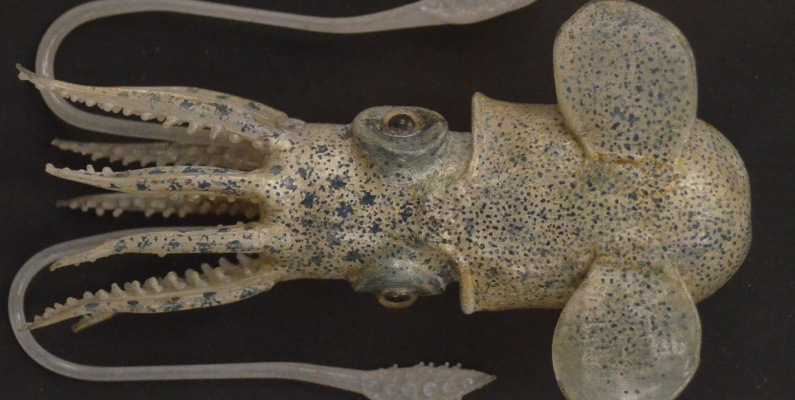
In celebration of the 10th International Penguin Conference that is happening right now in Dunedin, On Lee Lau, Otago Museum's Assistant Collection Manager, Natural Science, is here to tell you about penguins' favourite food: squid!
Squid belong to a group called cephalopods, which also includes cuttlefish, nautilus, and octopus. Scientists who study cephalopods are called teuthologists. Teuthologists have big challenges in studying this interesting group of molluscs, because these animals often live very deep in the ocean. Adding to the challenge, many cephalopod species display intelligence, with complex behaviours, and some even have ability to camouflage in their environment.
Cephalopods have developed big eyes adapted to detect prey and predators in their deep-sea environment. Both squid and octopuses have blue blood, this is because they use an oxygen-carrying molecule that contains copper, called haemocyanin, in their blood.
Squid have a streamlined body, eight arms, two tentacles, and two fins on their mantle. Most squid species have also a flexible backbone, called a pen, or gladius, that is mostly made of chitin.
Arrow squid (Nototodarus gouldi and Nototodarus sloanii ) are an important food for New Zealand’s penguins, including kororā (the little blue penguin), hoiho (the yellow-eyed penguin) and tawaki (the Fiordland crested penguin), as well as for commercial fisheries in New Zealand. These squid are commonly found in the open ocean across New Zealand’s continental shelf, where they live in large schools.
Image: Diorama of two Little blue penguins (Eudyptula minor). Otago Museum Collection. AV9266 © Otago Museum
A recent deep-sea expedition to the Kermedec area discovered several species new to science and species not previously known to live in New Zealand waters. There are more than 90 different species of squid in the oceans surrounding New Zealand, and very little is known about most of them.
Several deep-sea creatures, including a Wonky-eyed squid (Histioteuthis), are featured in NIWA’s exhibition, which highlights its work in New Zealand’s marine realm at Otago Museum’s Beautiful Science gallery.
Top Image: Dwarf bobtail squid (Sepiola rondeletii) glass model. Otago Museum Collection. IV4870. On Lee Lau © Otago Museum.
Sources:
Henk-Jan T. Hoving, Jose Angel A. Perez, Kathrin S.R. Bolstad, Heather E. Braid, Aaron B. Evans, Dirk Fuchs, Heather Judkins, Jesse T. Kelly, José E.A.R. Marian, Ryuta Nakajima,Uwe Piatkowski, Amanda Reid, Michael Vecchione and José C.C. Xavier. (2014) The Study of Deep-Sea Cephalopods. In Erica A.G. Vidal, editor: Advances in Marine Biology, Vol. 67, Oxford: United Kingdom, pp. 235-359.DOI: 10.1016/B978-0-12-800287-2.00003-2
Rebekah White. (2019) New squid on the block. New Zealand Geographic. Issue 157. www.nzgeo.com/stories/new-squid-on-the-block/
Vancouver Aquarium. www.vanaqua.org/education/aquafacts/octopuses-and-squids
New Zealand Birds Online. nzbirdsonline.org.nz
Fisheries New Zealand. fs.fish.govt.nz
National Institute of Water and Atmospheric Research. www.niwa.co.nz/blogs/critteroftheweek/183
